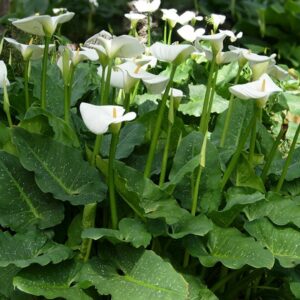Your cart is currently empty!
Plant Calla Lilies in the Ground: A Comprehensive Guide to Success

Introduction
Calla lilies, with their elegant funnel-shaped blooms and sword-like foliage, add a touch of sophistication to any garden. While they are often grown in containers, planting them in the ground allows them to thrive and produce stunning displays year after year. This comprehensive guide will provide you with all the essential information and tips to ensure success in planting calla lilies in the ground.
Choosing the Right Location
Selecting the ideal location is crucial for the growth and performance of your calla lilies.
Sunlight Requirements:
Calla lilies prefer full sun to partial shade. They tolerate morning sun with afternoon shade, but avoid planting them in areas with excessive shade, as this can stunt their growth and affect flowering.
Soil Conditions:
Well-drained, fertile soil is essential for calla lilies. They prefer a soil pH level between 6.0 and 7.0. Amend the soil with compost or manure to improve drainage and fertility.
Planting Time and Method
The optimal time to plant calla lilies is in the spring or fall, when the soil temperature is between 60-65°F (16-18°C).
Planting Depth:
Dig a hole twice the width of the tuber and 2-3 inches deep. Place the tuber in the hole with the root end facing down. Cover the tuber with soil, firm it gently, and water thoroughly.
Spacing:
Space the tubers 12-18 inches apart to allow for proper growth and air circulation.
Watering and Fertilizing
Watering:
Water calla lilies deeply and regularly, especially during hot and dry weather. Allow the top few inches of soil to dry out before watering again. Avoid overwatering, as this can lead to root rot.
Fertilizing:
Fertilize calla lilies every 3-4 weeks during the growing season with a balanced liquid fertilizer. Avoid using fertilizers with high nitrogen content, as this can promote foliage growth at the expense of flowering.
Mulching and Winter Care
Mulching:
Apply a layer of organic mulch, such as bark chips or compost, around the calla lilies to retain moisture, suppress weeds, and regulate soil temperature.
Winter Care:
In colder climates, calla lilies may need protection from frost. Cut back the foliage to about 6 inches and mulch around the tubers with straw or leaves. In extremely cold climates, consider lifting the tubers and storing them indoors over the winter.
Common Pests and Diseases
Calla lilies are generally hardy plants, but they can be susceptible to certain pests and diseases.
Common Pests:
* Aphids
* Spider mites
* Thrips
Common Diseases:
* Root rot
* Leaf spot
* Botrytis blight
Practice good garden hygiene and regularly inspect your plants for signs of pests and diseases. If necessary, treat with appropriate pesticides or fungicides.
Harvesting and Storage
Calla lilies typically bloom in the summer. Once the blooms have faded, you can harvest the flowers for bouquets or decorative purposes. To harvest, cut the stems close to the base of the plant.
If desired, you can also harvest the tubers in the fall. Dig up the tubers carefully and allow them to dry in a warm, well-ventilated area. Store the tubers in a cool, dark place over the winter.
Tips for Success
* Choose healthy, disease-free tubers.
* Prepare the soil properly before planting.
* Water regularly and deeply, especially during hot and dry weather.
* Fertilize regularly with a balanced liquid fertilizer.
* Mulch around the plants to retain moisture and suppress weeds.
* Protect the plants from frost in cold climates.
* Regularly inspect the plants for pests and diseases.
* Harvest the flowers and tubers as needed.
Additional Resources
* Growing Calla Lilies
* Growing Calla Lilies in the Home Garden
* Calla Lily Growing Guide
Conclusion
Planting calla lilies in the ground can be a rewarding experience, adding elegance and beauty to your garden. By following these comprehensive guidelines, you can enjoy vibrant blooms and healthy plants for years to come. Remember to choose the right location, plant at the appropriate time and depth, water and fertilize regularly, provide mulch and winter care, watch out for pests and diseases, and enjoy the fruits of your labor.








Leave a Reply